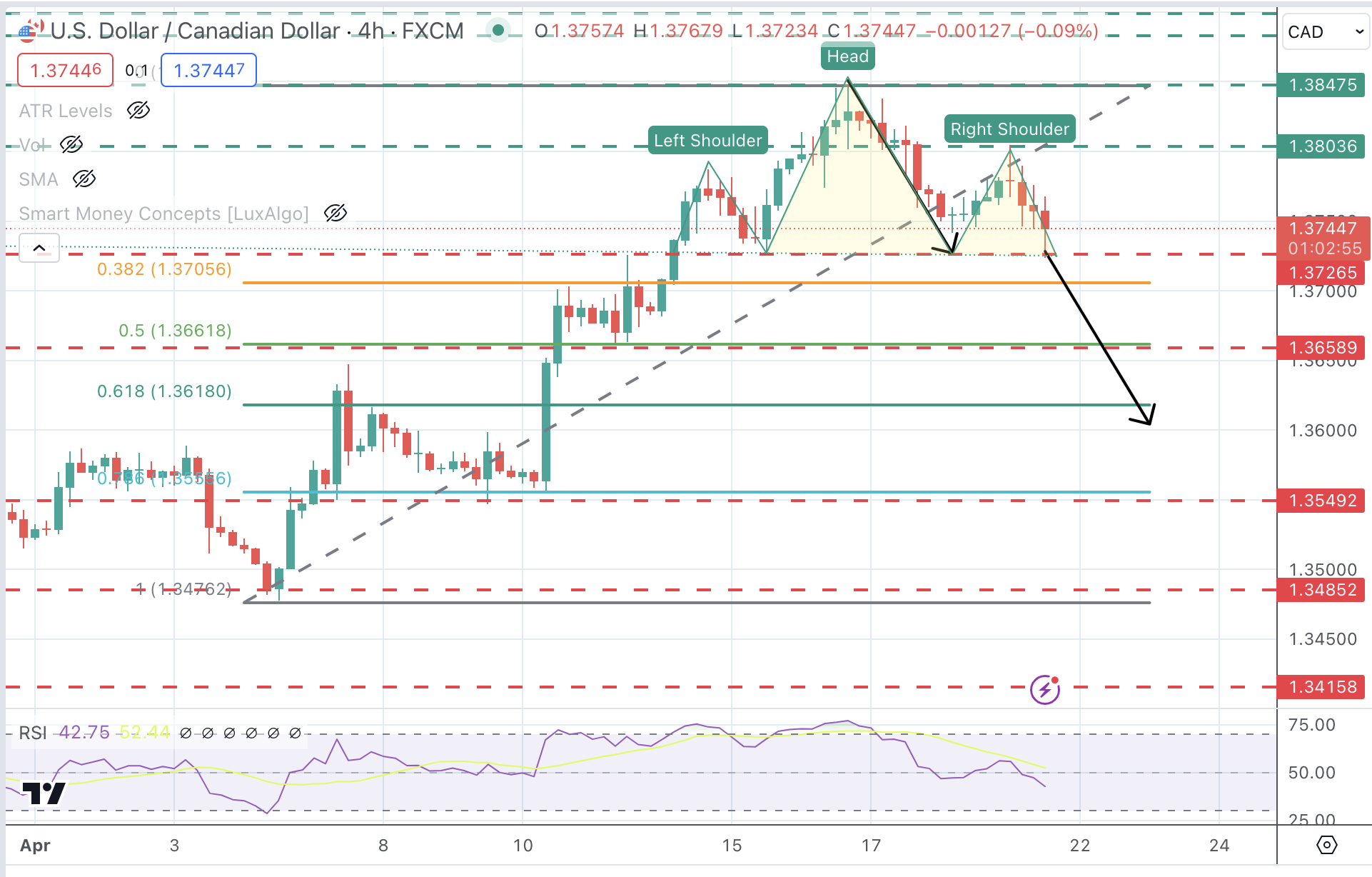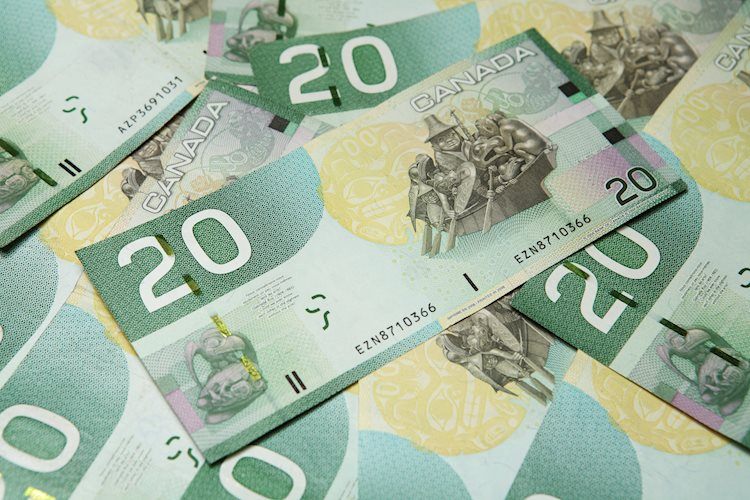Canadian Dollar picks up as the Dollar eases with risk aversion fading
- Canadian Dollar extends recovery in calm Friday trading session.
- Iran has downplayed the alleged drone attack from Israel, which has eased risk aversion.
- USD/CAD is testing the neckline of a bearish S&H pattern at 1.3725.
The Canadian Dollar (CAD) is trading higher for the third consecutive session on Friday and is on track for a moderate weekly recovery after a sharp sell-off over the previous two weeks. A softer US Dollar in the absence of key macroeconomic data and easing fears about the Middle East conflict are contributing to the Loonie’s recovery.
Investors seem to have come to terms with the idea that the Federal Reserve (Fed) will delay and scale down its monetary easing plans, which is allowing some take-profit for the US Dollar. Chicago Fed President Austen Goolsbee has reiterated the lack of progress on inflation, but the impact on the US Dollar has been marginal.
Furthermore, the Iranian authorities have played down rumours about a drone attack by Israel. With no further threat to an escalation of the conflict, the immediate risk aversion has gradually eased, which is good for the CAD.
Daily digest market movers: USD/CAD extends recovery as risk aversion eases
- Canadian Dollar appreciates further, favoured by a light US macroeconomic calendar and easing geopolitical concerns.
- Iranian government has downplayed the alleged attack from Israel and showed no intentions for retaliation, which has calmed markets.
- On Friday, Chicago Fed President Austen Goolsbee commented on the lack of progress on US inflation but remained confident in reaching the 2% core target in a reasonable time frame.
- This week, US data has added evidence of sustained economic growth with a tight labor market. This backs the idea that the US central bank will have to keep rates at a restrictive level for a longer time.
- Data from Canada reflects a softening inflationary trend, which highlights the diverging monetary policy outlook between the BoC and the Fed.
- Bets for a Fed rate cut in July have dropped to 38% from around 50% at the beginning of the week, with investors pricing in 40 bps of cuts in 2024, down from 150 bps in January.
Canadian Dollar price this week
The table below shows the percentage change of Canadian Dollar (CAD) against listed major currencies this week. Canadian Dollar was the weakest against the Swiss Franc.
| USD | EUR | GBP | CAD | AUD | JPY | NZD | CHF | |
| USD | -0.07% | 0.69% | -0.13% | 0.79% | 0.86% | 0.89% | -0.45% | |
| EUR | 0.08% | 0.76% | -0.06% | 0.89% | 0.93% | 0.97% | -0.36% | |
| GBP | -0.70% | -0.77% | -0.83% | 0.10% | 0.17% | 0.19% | -1.16% | |
| CAD | 0.13% | 0.06% | 0.80% | 0.95% | 0.99% | 1.03% | -0.31% | |
| AUD | -0.80% | -0.90% | -0.15% | -0.96% | 0.04% | 0.08% | -1.27% | |
| JPY | -0.86% | -0.94% | -0.15% | -1.00% | -0.06% | 0.05% | -1.30% | |
| NZD | -0.89% | -0.98% | -0.23% | -1.04% | -0.08% | -0.04% | -1.34% | |
| CHF | 0.44% | 0.36% | 1.12% | 0.30% | 1.25% | 1.29% | 1.33% |
The heat map shows percentage changes of major currencies against each other. The base currency is picked from the left column, while the quote currency is picked from the top row. For example, if you pick the Euro from the left column and move along the horizontal line to the Japanese Yen, the percentage change displayed in the box will represent EUR (base)/JPY (quote).
Technical analysis: USD/CAD forms bearish Head & Shoulders pattern with key support at 1.3725
The broader US Dollar trend remains positive, but the reversal from the 1.3800 area earlier on Monday suggests a Head & Shoulders pattern is in progress. This is a common figure to signal a trend shift and comes after a near 3% USD rally in April.
Immediate support is at 1.3725, which is the neckline of the H&S pattern. Below here, the next support levels are 1.3665 and the target of the figure, coincident with the 50% Fibonacci retracement of the April rally at 1.3620. On the upside, above 1.3800 the focus would shift back to the 1.3850 high.
USD/CAD 4-Hour Chart

US Dollar FAQs
The US Dollar (USD) is the official currency of the United States of America, and the ‘de facto’ currency of a significant number of other countries where it is found in circulation alongside local notes. It is the most heavily traded currency in the world, accounting for over 88% of all global foreign exchange turnover, or an average of $6.6 trillion in transactions per day, according to data from 2022. Following the second world war, the USD took over from the British Pound as the world’s reserve currency. For most of its history, the US Dollar was backed by Gold, until the Bretton Woods Agreement in 1971 when the Gold Standard went away.
The most important single factor impacting on the value of the US Dollar is monetary policy, which is shaped by the Federal Reserve (Fed). The Fed has two mandates: to achieve price stability (control inflation) and foster full employment. Its primary tool to achieve these two goals is by adjusting interest rates. When prices are rising too quickly and inflation is above the Fed’s 2% target, the Fed will raise rates, which helps the USD value. When inflation falls below 2% or the Unemployment Rate is too high, the Fed may lower interest rates, which weighs on the Greenback.
In extreme situations, the Federal Reserve can also print more Dollars and enact quantitative easing (QE). QE is the process by which the Fed substantially increases the flow of credit in a stuck financial system. It is a non-standard policy measure used when credit has dried up because banks will not lend to each other (out of the fear of counterparty default). It is a last resort when simply lowering interest rates is unlikely to achieve the necessary result. It was the Fed’s weapon of choice to combat the credit crunch that occurred during the Great Financial Crisis in 2008. It involves the Fed printing more Dollars and using them to buy US government bonds predominantly from financial institutions. QE usually leads to a weaker US Dollar.
Quantitative tightening (QT) is the reverse process whereby the Federal Reserve stops buying bonds from financial institutions and does not reinvest the principal from the bonds it holds maturing in new purchases. It is usually positive for the US Dollar.
Forex News
Keep up with the financial markets, know what's happening and what is affecting the markets with our latest market updates. Analyze market movers, trends and build your trading strategies accordingly.
